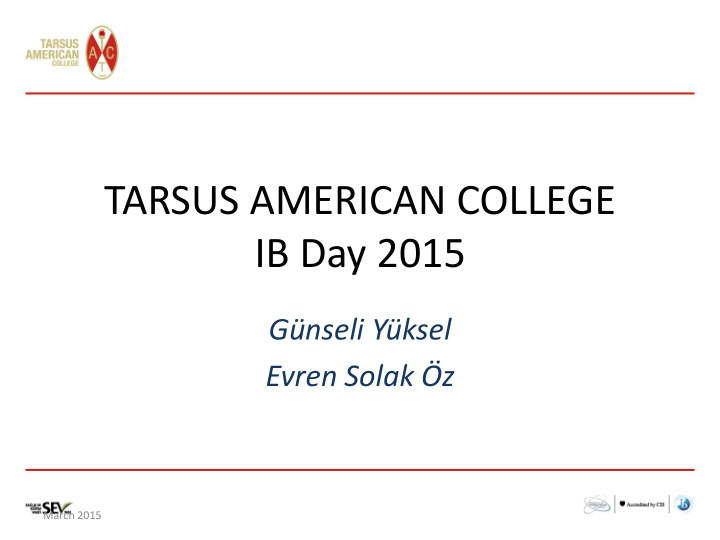



TARSUS AMERICAN COLLEGE IB Day 2015 Günseli Yüksel Evren Solak Öz March 2015
What does ‘concept’ mean? March 2015
A general idea derived from specific instances March 2015
What does ‘ concept based teaching ’ mean? March 2015
Concept based teaching in IB March 2015
IB LP Aims and Objectives March 2015
Group 1- Language A: encourage, through the study of texts, an appreciation of the different perspectives of people from other cultures, and how these perspectives construct meaning – open-minded, knowledgeable Group 3 – TITC – develop an appreciation of historical, geographical and sociological inquiry from various perspectives – open-minded, knowledgeable Group 5 – Mathematics - appreciate the international dimension in mathematics through an awareness of the universality of mathematics and its multicultural and historical perspectives - open-minded, knowledgeable March 2015
WHAT DO WE TEACH? & HOW DO WE TEACH? March 2015
FACTS OR IDEAS features of Definitions of simile, communication define metaphor... the communicator’s style The areas of the increasing world that have human/environmental overpopulation interactions change the environment Definition of media perpective shapes our literacy opinions March 2015
For HIGHER LEVEL THINKING By using ‘ specific instances, ’ we teach the general ideas, which are transferrable across the various contexts. March 2015
Bloom’s Taxonomy &Concept Based Model Knowledge Dimensions March 2015
Cognitive Processes UNDERSTAND REMEMBER ANALYZE EVALUATE CREATE APPLY Knowledge FACTUAL List Summarize Classify Order Rank Combine CONCEPTUAL Describe Interprete Experiment Explain Assess Plan PROCEDURAL Tabulate Predict Calculate Differentiate Conclude Compose METACOGNITIVE Appropri Execute Construct Achieve Action Actualize ate Use March 2015
Texas Depth and Complexity Model March 2015
Concept Based Teaching Requires ; • Synergistic Thinking • Transfer of Knowledge • Social Construction of Knowledge March 2015
Synergistic Thinking March 2015
Transfer of Ideas The chalkboard Universe by Rob Gonsalves March 2015
Collaborative work March 2015
SOME KEY CONCEPTS Conflict Power Identity Complexity Influence Patterns Beliefs and values System Relationships Paradox Balance Origins Interdependence Structure/Function Change Interactions Innovation Revolution Freedom Design Perspective Transformations Genius Force Aesthetics Reform Creativity Heroes March 2015
Subject Area Concepts SCIENCE SOCIAL STUDIES CONCEPTS WRITER’S READER’S CRAFT IN TEXT CRAFT Order Conflict/Cooperati Prejudice Organization Inference Organism on Perspective Word Choice Context Clues Population Patterns Conflict Context Meaning System Supply/Demand Cooperation Conventions Paraphrase Change System Power Fluency Summary Evolution Change/Continuity Relationships Voice Text Structure Cycle Culture Envy Presentations Reading Rate Interaction Scarcity Emotions Symbolism Directionality Energy Civilization Oppression Allegory Self-regulation Matter Interdependence Influence Metaphor Imagery Equilibrium Cycle Protagonist Genre Antagonist Background Knowledge March 2015
Concept: INTERDEPENDENCE March 2015
English Topic: Speech-Assimilation It is concerned with one sound becoming phonetically similar to an adjacent sound . The plural of ‘Dog’ is ‘dogs’ and pronounced with /z/- FACT March 2015
Sociology Assimilation in sociology , is the blending of minority groups into the dominant society; Ex:Blending of European immigrants into American society. March 2015
Biology Assimilation in biology is the transformation of external materials into substances inside the body that help the body to grow and function normally.. Example of biological assimilation; Photosynthesis... March 2015
FACTS OR IDEAS Phonetic variety due to The interdepended affixation relations built or among the parts of a whole as a result Timeline for blending of their interaction of European immigrants into American society. or Food processing inside the human body March 2015
THE FACTUAL KNOWLEDGE IS LOCKED IN TIME, PLACE or SITUATION whereas CONCEPTS TRANSFER THROUGH TIME, ACROSS CULTURES, AND SITUATIONS March 2015
ENGLISH Concept: Style /Uniqueness Topic: Figurative Language Question: How does style influence the communication? March 2015
ENGLISH Read the text Identify and Explain the literary device Analyze their effect on meaning. Rewrite the same extract in your own words and compare it with the original one Create an image to give the same message March 2015
ENGLISH Bloom’s Taxonomy: Remember, Understand, Analyze, Create, Transfer knowledge (Texas Depth and Complexity Model LP: communicator; thinker Understanding: shape or form influence meaning. The way a meaning is transferred is unique to its transmitter and defines his/her identity. March 2015
CONCEPT:Change GEOGRAPHY: Change in the structure of a landscape alters the ecosystems within that landscape. • Change-ecosystems- Interdependence • Three Gorges Dam in China • Location of the dam, important environmental issues caused by it March 2015
CONCEPT:Change HISTORY: The developments that occured in the world history led to changes in politics, economies and culture of today’s countries. • Change-Culture- Interdependence WW 1 Causes and results of WW1 March 2015
CONCEPT:Change ENGLISH: Language, culture and context change the ways in which meaning is constructed and received. Change-context-meaning- culture-interdependence Hamlet Information about the author,cultural and political context in which the play was written March 2015
CONCEPT:Change PHYSICS : Energy can change from one form to another yet the total amount of energy is conserved. Energy is neither created or destroyed. Change-Transformations- Energy Energy Conservation; Energy Transformations Kinetic Energy, Gravitational Potential Energy, Mechanical Energy, Energy Lost Due to Friction March 2015
Works Cited Page • Erickson, Lynn. Concept Based Curriculum and Instruction for the Thinking Classroom. California: Corwin, 2007. Print • Forehand , Mary. “Bloom’s Taxonomy”. Emerging Perspectives on Learning, Teaching, and Technology. Ed. Michael Orey. MediaWiki. 2005. Web. 12.03.2015 • Stephen. “Teach ing in the Third Dimension: Moving into Concept-based Curriculum.” I-Biology – Reflections. Wordpress. 24 July 2012. Web. 15.03.2015 • H. Lynn Erickson: Concept-based teaching and learning . IB Position Paper. • Gonzalves,Rob. ‘‘Magic Realism of Rob Gonzalves’’. Saper Galleries. Web. 19.03.2014 • Wikipedia contributors. "Concept." Wikipedia, The Free Encyclopedia . Wikipedia, The Free Encyclopedia, 20 Feb. 2015. Web. 19 Mar. 2015. March 2015
Recommend
More recommend